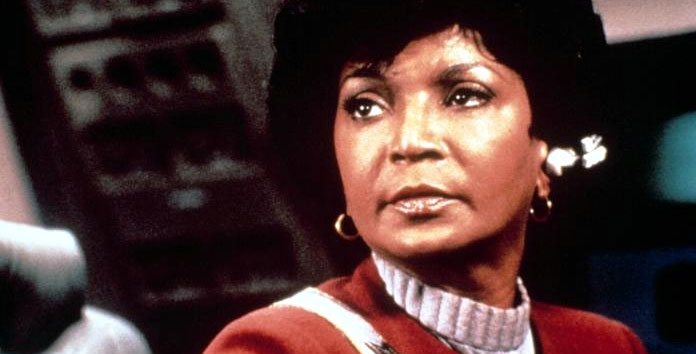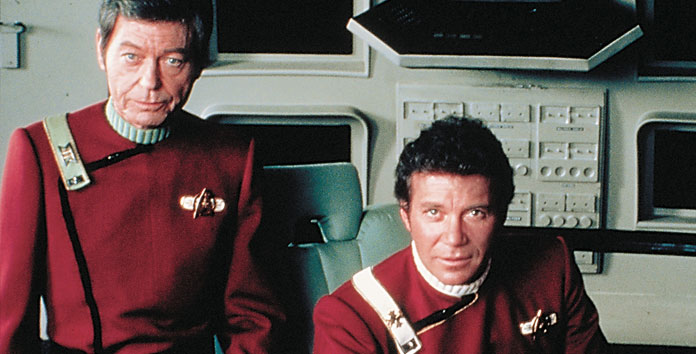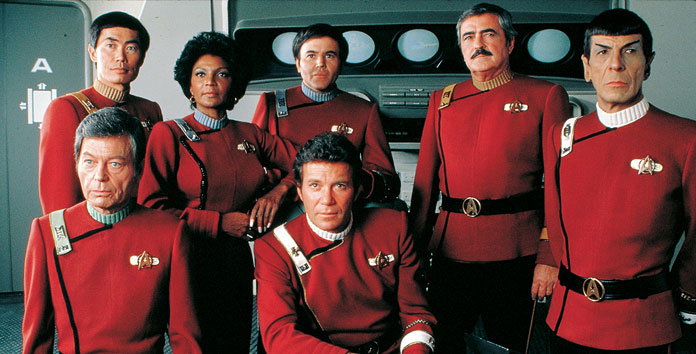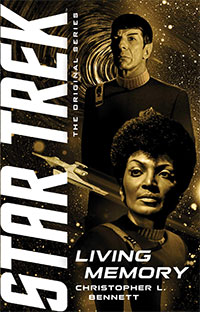Christopher L. Bennett returns to the classic Star Trek movie era in this month’s new novel Star Trek: The Original Series — Living Memory, building upon last year’s The Higher Frontier and continuing his quest to chronicle the events leading up to Star Trek II: The Wrath of Khan.
Living Memory is an ensemble story for the original Enterprise crew, set in a relatively unexplored period of their lives — right after Admiral James T. Kirk has been appointed commandant of Starfleet Academy.
The book comprises two main storylines (one excellent, one okay, but more on that later); the main story featuring Nyota Uhura with a supporting role from Spock and Scotty, and the secondary story featuring Kirk with a supporting role from McCoy and Sulu.
While this is definitely an ensemble book, Uhura is the character who gets the biggest spotlight as Bennett explores the character and revisits an important moment in the character’s life from her Original Series years.
Bennett’s stories tend to rely upon extrapolating upon something that remains unexplained or appears contradictory in the Star Trek canon. Last year’s The Higher Frontier, for example, is structured around exploring why so many Original Series episodes seem to feature humans with telepathy, but by the time of The Next Generation that never comes up again.

In this case of Living Memory, Bennett chooses to devote the excellent main plot line of his book to exploring the fallout from Uhura’s encounter with the Nomad probe in “The Changeling,” when it completely wiped her memory. Though the show was quick to move on from that narrative development, Bennett returns to it and explores the impact that such a profound event must surely have had on Uhura’s life.
In addition to the important character growth for Uhura that asks questions around how anyone would react in such a situation — and how they might relate to friends, family, colleagues, and even former lovers — Bennett gives the main plot of the book a strong science fiction backdrop as mysterious anomalies impact Federation territory… and all signs point back to a connection to Uhura that she cannot explain or remember.
It’s rare that Uhura gets such a strong outing, even in the books, and it’s pleasing to see this year’s Original Series novel have a strong through line for the character. Living Memory affords Uhura some of the back story, development, and space to breathe that she was denied on The Original Series. I liked everything about this storyline; it was gripping and unpredictable.

Meanwhile, Admiral Kirk is settling into his position as the day-to-day administrator of Starfleet Academy, and must grapple with trying to integrate a group of specially-bred warriors from the planet Arcturis into Starfleet Academy. Arcturians were mentioned a couple of times in the Original Series — and then seen as one of the many background aliens in The Motion Picture — so it’s fun to get more information on the race and their motivations.
This subplot of the book attempts to explore interesting questions around the role of Starfleet, which has always sat uncomfortably between that of peaceful explorers and the Federation’s military. The book also allows for more exploration of the Federation’s stance on genetic engineering; this time that has been carried out by another race, and not by humans.
However, this storyline is weaker than the Uhura half of the novel. On the way to its resolution, the story casts off a lot of the more interesting questions in favor of becoming a standard murder mystery (with a somewhat forced ending). It is great to see Kirk in a different situation — and how he handles being the leader of Starfleet Academy — but the Arcturian story never reaches the same heights as the Uhura storyline. It does feature a nice romantic subplot for McCoy, though.

In addition, the two main storylines of the novel — the anomalies’ impact on the Federation and their connection to Uhura, and the effort to integrate the Arcturians into Starfleet Academy — sit somewhat uncomfortably together. There are almost no points of connection, whether narratively or thematically, between these disparate stories, and at some points you feel like you’re reading two separate novels whose chapters have been
In some ways, I would have preferred de-emphasizing Kirk’s role in the book, dropping the Arcturian story entirely, and expanding the Uhura plot. That probably wasn’t what the publisher wanted; Kirk sells a lot of books, I’m sure, but as he’s not even featured on the cover art, it feels like the way this novel ultimately should have been structured.
Overall, the Uhura main story for Living Memory is more than worth the price of admission and is one of Christopher L. Bennett’s most interesting science fiction stories in his career. The Arcturian story is fine, but it just can’t compete with the rich character work for Uhura that expands on events from the Original Series.
![]()
Star Trek: The Original Series — Living Memory is in stores and available from online retailers now.

